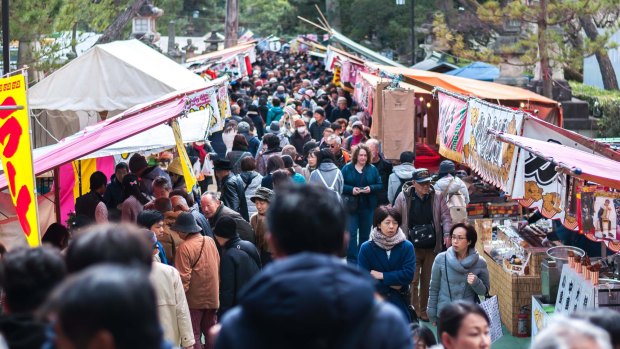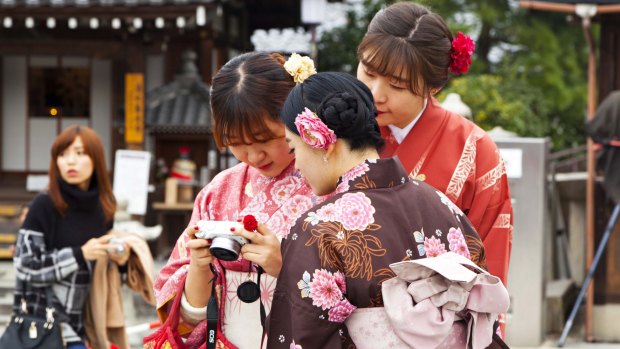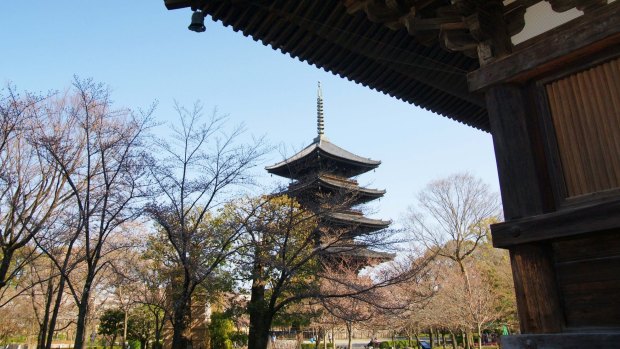This was published 5 years ago
Kyoto, Japan, places to shop: Shrine and temple markets offer culture and shopping
By Lesley Holden

Shopping at Kitano Tenmangu Shrine. Credit: Shutterstock
In Kyoto, going early to a temple or shrine market seems a sure way to beat the crowds. What better way to linger and contemplate these sacred sites than with bit of browsing. Across Japan, some of these markets, that originally catered for pilgrims, have been going for hundreds of years.
Australian designer Sally Smith, now based in Kyoto with her three children, helps me bookend my week around two such markets. An avid collector of Japanese fabric, kimono and objects, Sally is the perfect guide. She'll meet me at the To-ji Temple for the Kobo-san market held on the 21st of each month and the other, Tenjin–san at the Kitano Tenmangu Shrine on the 25th of the month.
I've ticked off only three of the more than 1600 Buddhist temples and 400 Shinto shrines in Kyoto. Even in winter there are crowds, especially at the Kiyomizu-dera Temple where groups of Japanese girls in rented kimonos pose for extended selfie sessions.

Japanese girls look the part at Kiyomizu temple. Credit: Shutterstock
The shimmering gold Kinkaku-ji and the Fushima Inari with its stone foxes and tangerine Torii gates winding up the sacred mountain are another stunning must-see.
Toji Temple is one of a collection of designated UNESCO sites that form the "Historic Monuments of Ancient Kyoto" World Heritage Site. Kobo-san market was named in honour of the monk Kobo Daishi, who died on March 21 in 835. And this market has been going for hundreds of years.
I get there about 8am. The temple, with its iconic five-story pagoda, the tallest in Japan, towers over the market. People are praying, others are setting up stalls selling chestnuts. Under a bright sky it's foot-stomping cold. Elderly locals buy bunches of pine for their spiritual significance. Artists set up displays of beautifully crafted ceramics.

Toji temple, Kyoto Japan. Credit: Shutterstock
I find the antique dealers' rows and I am thrown by my lack of knowledge on the function and value of what is on offer. There are brass and cast iron objects, old tools and boxes with trays of miniatures – pickle dishes, tea and sake cups and figurines. There are geiko (the Kyoto word for geisha) and maiko (apprentice) hair ornaments, makeup brushes, scrolls, swords and bric-a-brac. Boxes of Kokeshi cylindrical wooden dolls, enlarged heads like a pepper mill, come in a range of sizes. I am drawn to a display of gold painted model cars. They are early Toyota Corolla music boxes. Others hold cigarettes. They are surprisingly heavy so I settle on a lightweight Kokeshi.
Feeling the cold, I head to the food stalls and decide to sample "tempura of pond smelt". I should have known better than to eat small fried fish at breakfast. After a swig of water I rush for an obanyaki, a simple custard pancake.
By 10am the entrance to the market is as crowded as a Tokyo train station at peak hour. The crush at food stalls disrupts the flow. I blame the takoyaki (octopus balls) with Kewpie mayo and okonomiyaki (savoury pancake). You'll also find dishes such as karaage (fried chicken), taiyaki (cakes shaped like fish), bean paste cakes and mitarashi dango, a rice ball smothered in a sweet sticky sauce.
I meet Sally outside the market and she leads me to rows of antique stalls that hug the perimeter wall. Here it's less congested and easier to browse. She points out blue and red Edo – kiriko cut glass vases, and zori – flat thongs made from old kimonos, traditionally made from straw.
Sally is adept at gently negotiating in Japanese and helps me secure a '60s metal vase for a good price. As a collector she's a frequent visitor, furnishing her two Kyoto guest houses with mid 20th century Japanese pieces and objects from temple markets. She's bought a third property – a Shiga Lake house outside Kyoto, that's awaiting her touch.
By passing the food stall scrum, we have a set lunch nearby and arrange to meet on the 25th at Kitano Tenmangu Shrine market. Sally says it has more antiques and will be less crowded, as it falls on a Thursday. The date also marks the death of the deity Sugawara no Michizane.
On Thursday It's below zero and snowing heavily at 7am as I walk to the station. I'm wearing two of everythingand look like an extra off Fargo. I rationalise this winter madness as life in Kyoto is wrapped around the changing seasons – especially spring and autumn. Being in this ancient city in snow is other-worldly.
I opt for a taxi, which slides on the icy streets, as do I when I cross the road to the shrine. Sally can't make it – it's too dangerous on her scooter on the icy roads. But she refers me to another Australian – Danny Matheson, and his partner Kazuo Ikeda, who have a coffee shop and residence in an old machiya or townhouse, nearby. Called Jam Jar Lounge and Inn, it sounds a perfect place to thaw out post-market with a shot of caffeine.
When I arrive there are few visitors in the shrine grounds. Some perform water purification rituals, pull the giant bell rope or pray. Others contemplate the sheer beauty of the shrine buildings, statues, plum orchard and maples laden with snow. Posing for photos on the a little bridge across the river is popular with couples. Priests dressed in white and miko, the female shrine attendants in their Inari tangerine voluminous skirt or pants, walk effortlessly on icy paths in traditional footwear in the falling snow. They sweep the snow away and prepare the hall. It's so quiet, despite the activity.
Back in the market the vendors are still setting up or huddling around kerosene heaters. Snow settles on bowls of fresh produce and bright beach umbrellas over a flower stall. The antique dealers' trays of tiny cups and ceramic animals are packed in ice. Wooden biscuit moulds, old lacquer and bamboo ware are under cover. Cast iron items lie in the snow, like a find from an archeological dig. In a sheltered stall I buy cups from a cache of '70s shop stock and an unadorned '30s lacquer pot. Time for that coffee.
Jam Jar is a slippery 10-minute walk from the market. The slatted wooden door opens to a cosy retro space. It's like a salon with velvet lounge chairs, a shared refectory table, bar seats and Danny's piano. Danny is immediately welcoming, like an old friend, speaking both English and Japanese to customers and guests. The excellent coffee quickens the heart and Ella Fitzgerald warms the soul.
Danny and Kazuo were drawn to the historic Nishijin weaving district because it has the largest concentration of traditional machiya in Kyoto. The 110-year-old machiya they bought used to be a factory for weaving obi, the sash worn around a kimono. Other machiya specialise in different aspects of kimono costuming such as thread or gold leaf. Kazuo used his background in Melbourne hospitality, commercial and retail design to re-purpose the space while maintaining its history. The old loom area with its high ceiling now has a staircase to a residence and guest accommodation. This is typical of a machiya – business at the front and residence out the back.
Danny says we are five minutes from Kamischiken, the oldest of the hanamachi or geiko area in Kyoto. It's named after the seven tea houses built from material left over from the rebuilding of the Kitano Shrine in the Muromachi era (1333–1573).
He points to a succession of white paper fans with red script on the wall. They are like a business card for geiko. One is a regular in her civvies at Jam Jar. No one would know, and Danny keeps her secret.
Danny says Jam Jar is about bringing a slice of Australia to Japan. They specialise in waffles and wine. He has one of the few espresso machines in Kyoto. It comes as no surprise to hear he had a cafe in Carlton and began Jam Jar in Battery Point in Tasmania. They returned to Japan taking the cafe name with them and their finely tuned sensibility – a blend of cafe culture and Japanese design.
Students often come in to buy coffee and practice their English. And who better to talk to than a convivial host. They also go the shrine, as the deity Sugawara Michizane is associated with the "Shinto god" of education, and pray for good marks.
Today there are other expats and plenty of young Japanese who have come from the market.My friend, who skipped the early morning for a sensible sleep, arrives and after more coffee and pastry we walk to Kamishichiken. White lanterns with red circles representing the crest of this area mark ancient tea houses or ochaya where geiko serve tea. The heritage street winds back to the antique stalls alongside the shrine. The ice has melted and my friend buys an end of day special from a stallholder keen to pack up.
These markets helped alleviate temple and shrine fatigue and made best use of my time. And thanks to a couple of expats with great local knowledge and a love of Japanese culture, I veered every so slightly off the tourist track for an enriching experience.
TRIP NOTES
MORE
FLY/TRAIN
JAL, ANA and Jetstar have many flights into Osaka and Tokyo. Connect with Shinkansen bullet trains to Kyoto. Use a pre-purchased Japanese Rail Pass. See jtbtravel.com.au/japan-rail-pass/national-rail-pass/
VISIT
Toji Temple see toji.or.jp/en/location/index.html
Kitano Tenmangu see kitanotenmangu.or.jp/top_en.php
STAY
Hotel Kanra Kyoto, five-star reimagined traditional Japanese rooms, minutes from the Higashi Honganji Temple hotelkanra.jp/en/
Lesley Holden travelled at her own expense.
Sign up for the Traveller Deals newsletter
Get exclusive travel deals delivered straight to your inbox. Sign up now.